Getting Things Done with Things 3
Follow my path of migrating to Things 3 after using OmniFocus for a decade.
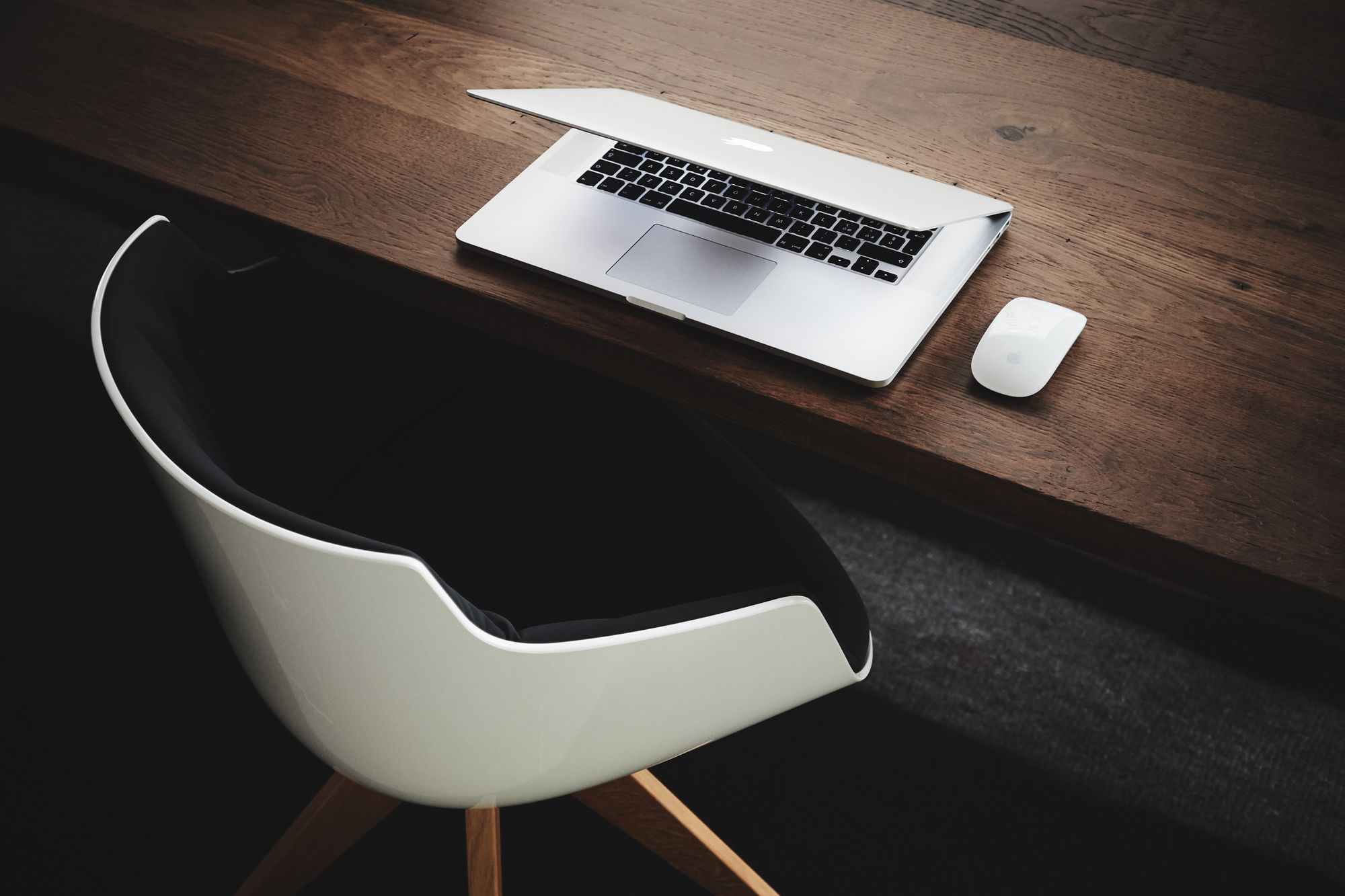
I have always looked for ways of working more efficiently, and being able to get the most out of every day by spending time on what is important and not necessary just the loud and urgent. What now seems like ages ago, I read a book called Getting Things Done by David Allen, and was intrigued by his approach to handling commitments, projects, deadlines — essentially anything that life hits you with.
Most people are accustomed to the idea of a calendar, a trusted place for keeping time based commitments. GTD is about having that for all your commitments and not just the hard landscape of a calendar. It provides a way of getting things out of your head into concrete actions, which means that you don't have to lay awake at night with thoughts swirling around. It also means that you can capture anything that is on your mind and be sure that it will be taken care of effectively, and in a timely manner. This provides the foundation for being able to engage with what you are currently doing with full confidence knowing that everything else is taken care of in an appropriate way.
Your head is for having ideas, not for holding them
— David Allen
There are essentially five steps to the basic GTD process:
- Capture: Use an in-basket or app to capture everything that has your attention. Little, big, personal and professional.
- Clarify: Take everything that you captured and ask: Is it actionable? If not, trash it, incubate it, or file it as reference. If yes, decide on the very next action required. If it takes less than 2 minutes, do it right away, if not, delegate where appropriate, or put it on a list to do when you can.
- Organize: Put action reminders on the right lists. For example, create lists for the appropriate context — calls to make, errands, computer related etc.
- Reflect: Look over your lists as often as necessary to determine what to do next. Do a weekly review to clean up, update your lists and clean your mind.
- Engage: Use your system to take appropriate actions with confidence.
For a deep dive into actually implementing GTD, make sure to read the book, since it will guide you through the entire process. There is also a GTD workbook being released later in 2019, which aims to act as a simple and practical guide for getting started with your own system.
OmniFocus
For the past decade, I have been using OmniFocus to implement my GTD system. I have seen it as a trusted companion, an external brain, that handles anything I throw at it. I have even written a setup guide, which guides you through the process of creating the views and workflows needed.
While it has been a battle tested companion for many years, I feel like I constantly have to fight the system, trying to mend it into doing what I want it to do. That coupled with the endless tweaking of perspectives made it hard to consider when asked to recommend a GTD tool to a colleague.
I did a quick review of current tools, trying out what seemed to be the most common ones. Part of this, I also ended up revisiting Things, which I used prior to moving to OmniFocus a long time ago. It has for the past 10 years become something of a powerhouse bundled into a beautiful and innocent looking package. This made the choice clear on what to recommend, but also got me thinking of trying it out for the duration of the trial period.
Things 3
The initial reaction when starting Things 3 is how clean and minimalistic the user interface is. Even though it has plenty of white space, it still manages to provide everything needed for a professional task manager, such as start and due dates for projects and actions, flagging (or starring in this case), tags and a hierarchical way of sorting projects.
While Cultured Code has written an introduction on how to become productive using Things, this is a walkthrough of my interpretation and implementation.
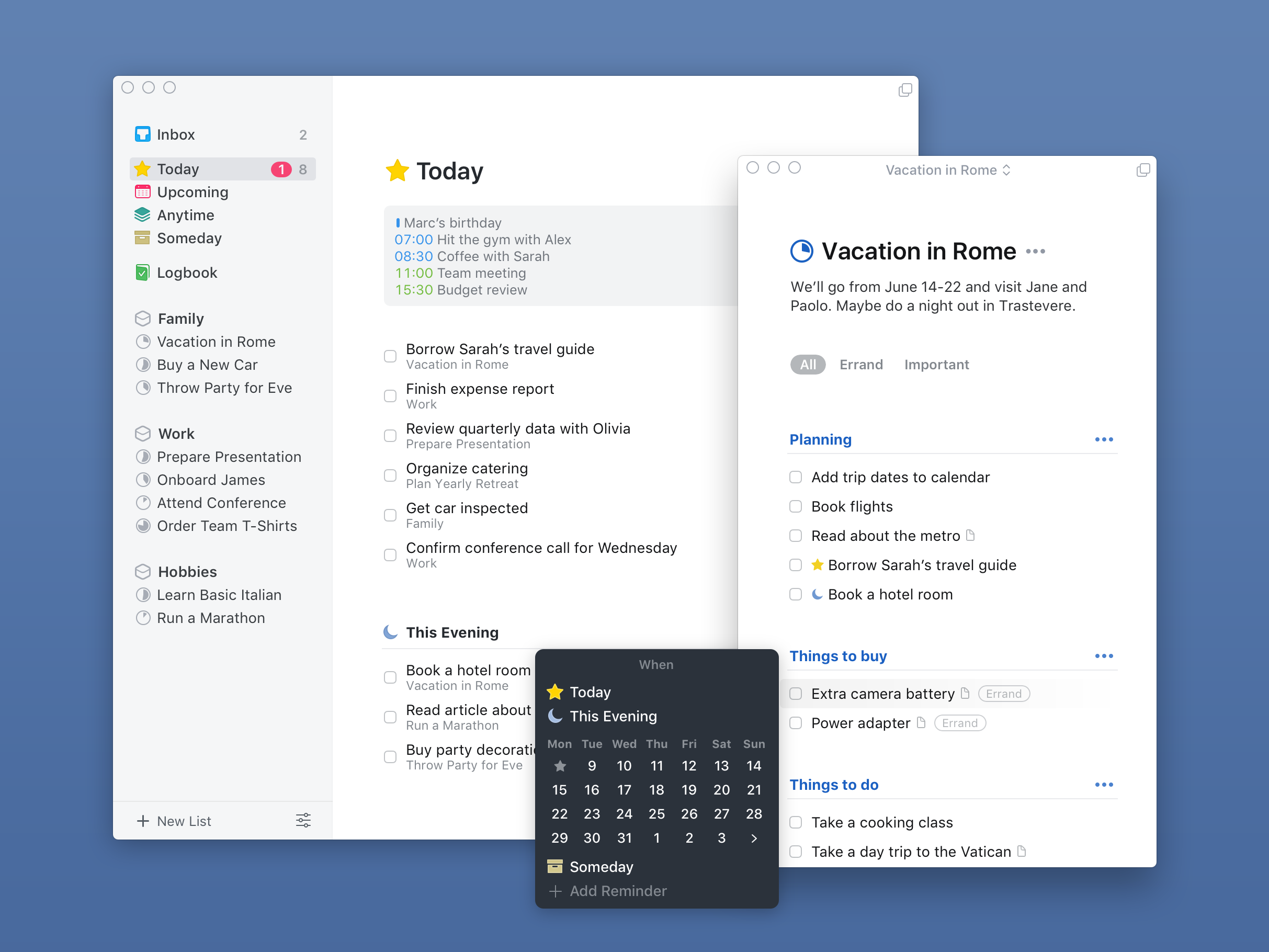
On the top level of the hierarchy are areas, which translate directly to areas of responsibility in GTD. This is where you define the areas of your life where you are responsible for the outcomes, and can include things like Family, Finance, Home, Client Projects, Company Strategy, but there's no one-size-fits-all here so defining these areas is an important step of setting up the GTD system.
In Things, areas can have tags, and I use that to group the areas into different categories, like Personal and Work. This lets me, for instance, easily filter out work related actions when I know I just want to focus on the personal areas, such as on the weekend.
Areas can contain projects as well as actions, which means that even though an action is not tied to a project, it can still fall underneath an area. This is one of the places where Things really shines, as it provides a holistic view of an entire area, independent of the technical details of a specific action.
Projects and actions in an area can have different statuses, where the normal is that they are active and can be worked on. Another status is Upcoming, which means that the project or action has a future start date, and this means that they won't be visible in the tags view so they can not actively be worked on until the start date and translates well to the tickler part of GTD. They can also be set to Someday, meaning that they will be inactive until a decision has been made to move them into active. This maps well to the Someday/Maybe lists in GTD.
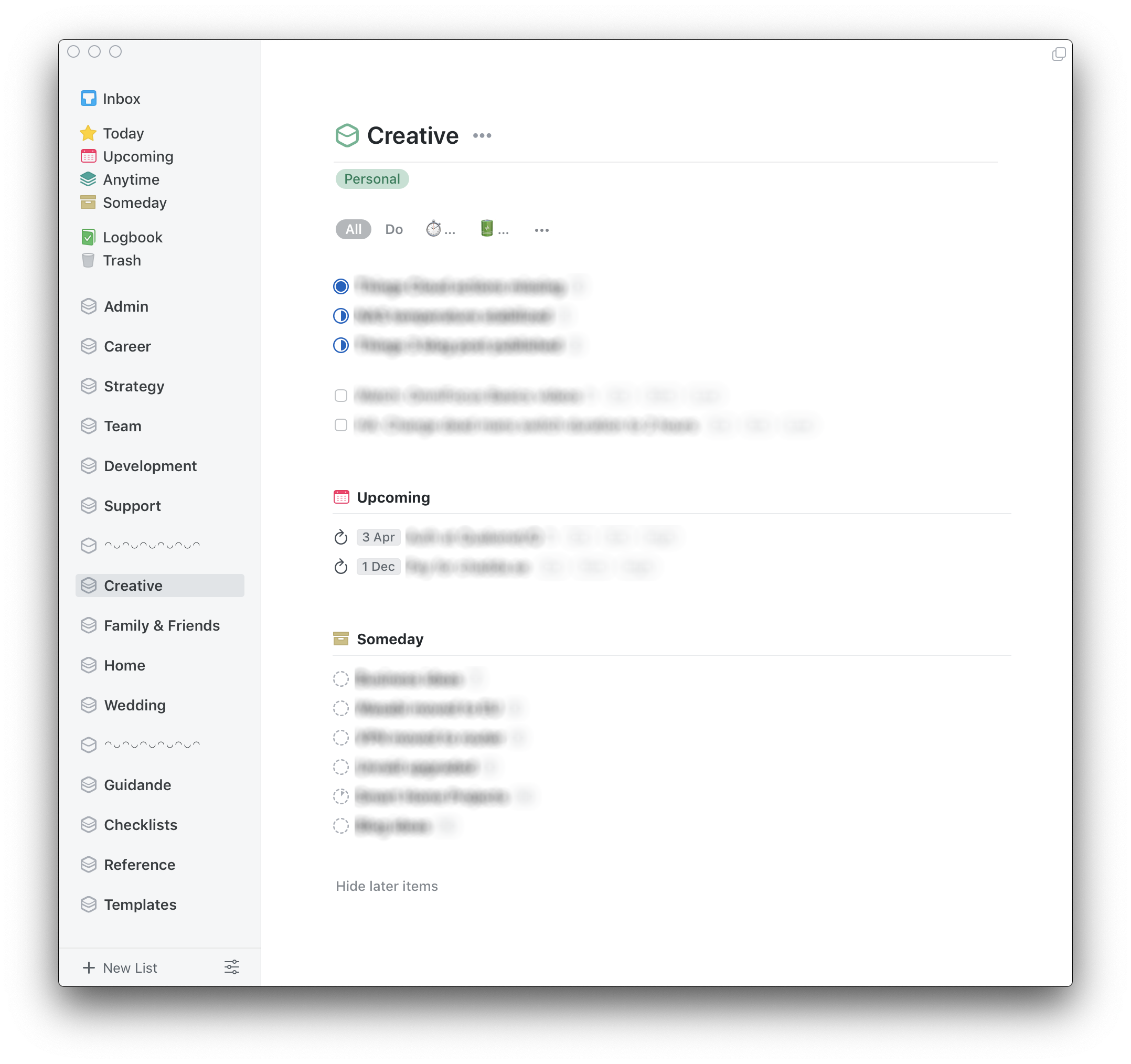
The main “take action” view is Anytime, where all actions that don't have a start date in the future or set to Someday are listed. There's a tag filter part of this view, where you can choose which actions should be displayed based on the tags they have. This also maps well to the GTD mindset where tags can represent contexts, energy levels and time available. The tags can be applied on the fly, so there's no need to create predefined views for the filtering you are currently looking for. It also means that it’s currently not possible to create a predefined view, but that hasn't bothered me so far.
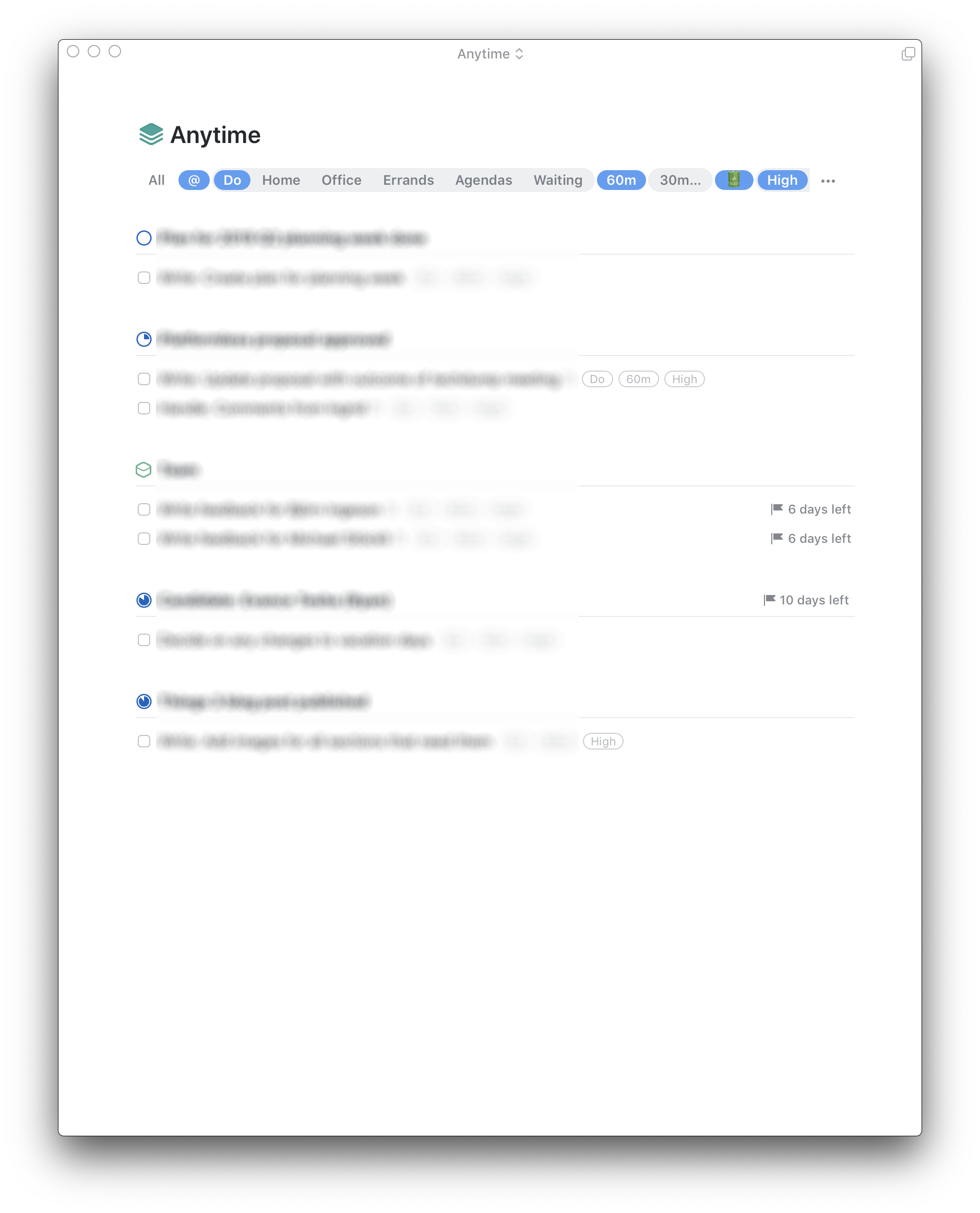
The coolest feature of this view is the ability to directly go to the project of an action in the list. This lets you easily access project level notes, see all next actions and other types of project related information. On iOS, there's a back button that returns you to the previous view once you're done in the project as well.
Actions can contain different types of information, such as a title and a note, as well as a start and due date, a project and any tags that you want. What differentiates an action in Things is the ability to create checklists within an action. This enables you to not only break down an action into smaller chunks of work, it also allows you to easily keep a log when working on an action that requires more than one session.

Being able to quickly jump to projects, or any type of list, makes working with Things very efficient. While most task managers allow searching for projects, actions and other information, no one does it as seamlessly as Things 3. The only thing you need is to just start typing. A search window will automatically pop up, providing you with relevant suggestions and allows you to refine your search and choose between potential matches.
Another very powerful feature is the way Things handles repeating actions. In OmniFocus, the next iteration of the action will be created from the one that was just completed. This means that if you need to, for instance, push the start date for a repeating action, all future versions of the action will have the pushed start date instead of the original. The same goes for other changes, such as flagging or modifying the due date. Things is different in that you create a repeating action, and every time a new version of that action becomes available, a separate instance of the action is spawned, which can be modified freely without affecting the repeating action itself. For me, this makes a lot more sense and provides the flexibility required when working with repeating actions.
Finally, Things 3 is visually pretty amazing. So much so, that I had to tweet about it.
https://twitter.com/johnnychadda/status/1102683954019270657
Organization
What makes Things so simple yet powerful comes from its simplicity and structure in how it allows you to organize all information. Areas and projects provides a distinctive structure, which at first may seem limiting, but that is also what sets it free from being something to tinker with.
I have a number of areas of responsibility for work and personal projects. Each area is tagged with an area group tag, meaning that all areas related to work are tagged work. Similarly, all areas belonging to my personal life are tagged accordingly. This allows me to later filter out actions and projects that I'm currently not interested to look at.
There's no way of visually distinguishing areas in the sidebar, which is why I have created two fake areas which are just dividers. This is just to visually separate the areas into groups, and serve no real purpose other than that.
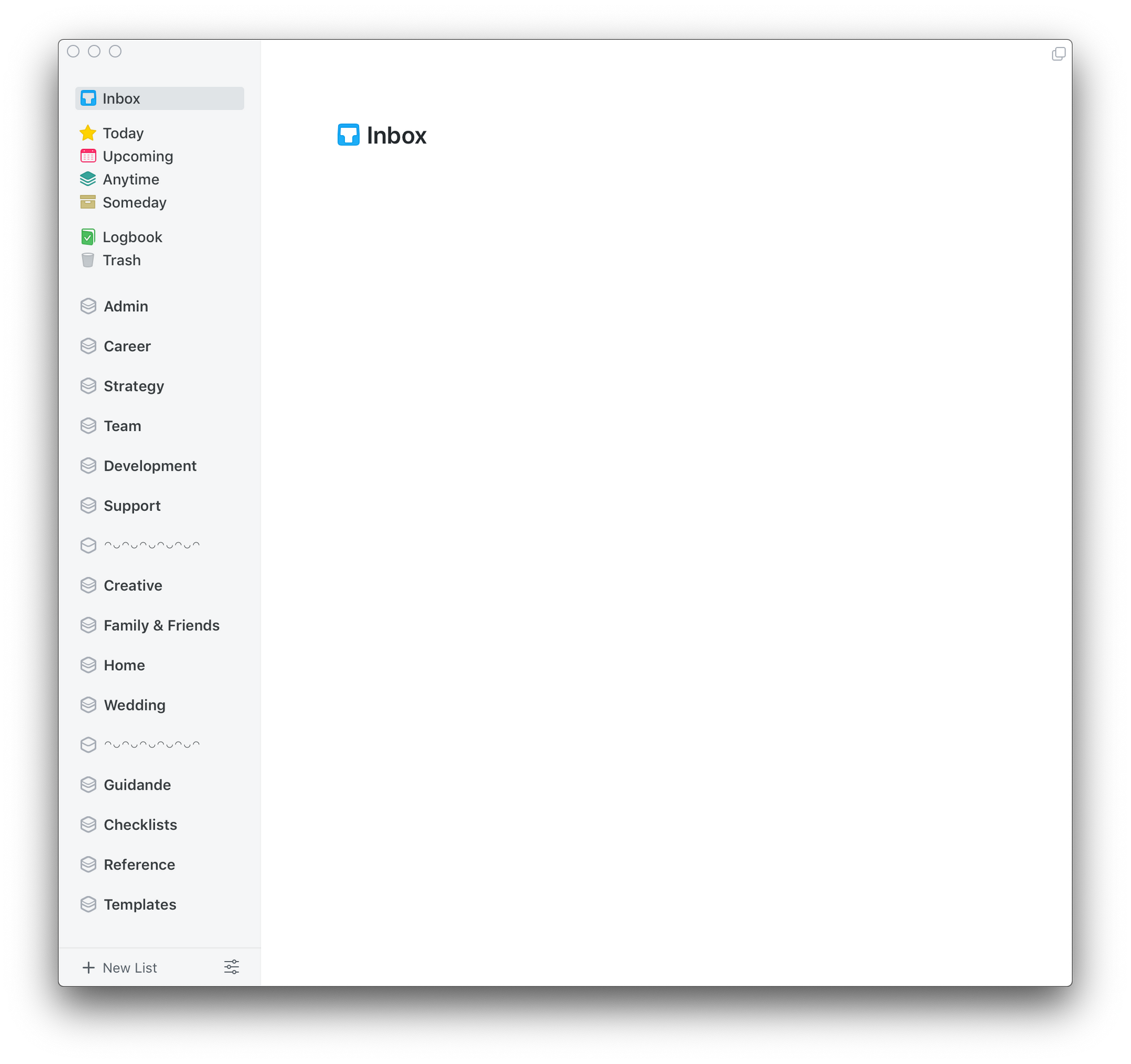
Projects are contained within the area they belong to, meaning I have no “loose” projects outside of an area. The only time that happens is if I have created a project on the fly from the Inbox and haven't filed it properly yet.
Areas can, in addition to projects, also contain actions. This is a change from OmniFocus where I needed to have single action lists for all actions not belonging to a project. Now I can just stick them in the relevant area, which makes getting an overview over everything in an area so easy, because everything from projects, single actions, future projects and someday lists are in the same place.
When first moving over to Things 3, I retained the tags from OmniFocus verbatim. The @computer context was for instance split up into three categories:
- dashes: short time, high focus
- focus: long time, high focus
- lounging: long time, low focus
That setup has been working great, and was necessary because of the way OmniFocus didn't allow one to easily choose which tags to show on the fly without creating a custom perspective. When moving to Things however, choosing a combination of tags is easy, which means that I don't have to limit myself to the three categories above. What I instead did was to separate the time and energy available tags from the actual context, which is the way it is recommended in the GTD book1. That also means that those constraints can be applied to which ever context I'm working from, be it @computer2, @home or @office.
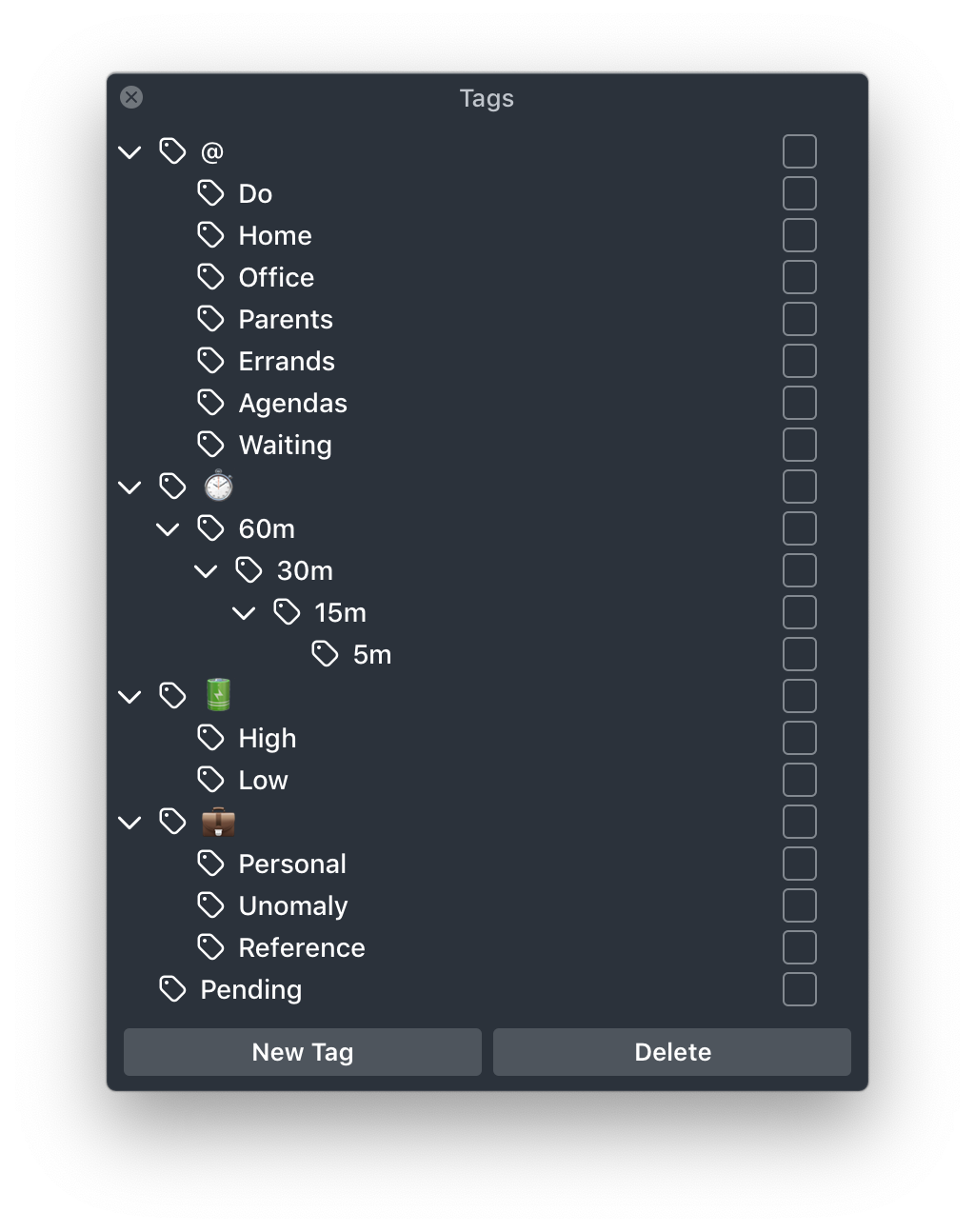
I structure the time available tags hierarchically. Using the effect of inheritance, it allows me to for instance choose the “30m” tag, and have Things show me everything that takes 30 minutes or less. If the tags were ordered next to each other, I would only see the actions tagged specifically with “30m”.
The Today and Upcoming views are built into Things, and I use those as part of my Daily Review to get a quick glance of the day ahead. It neatly highlights the starred actions which I have marked as something I need to keep a special lookout for.
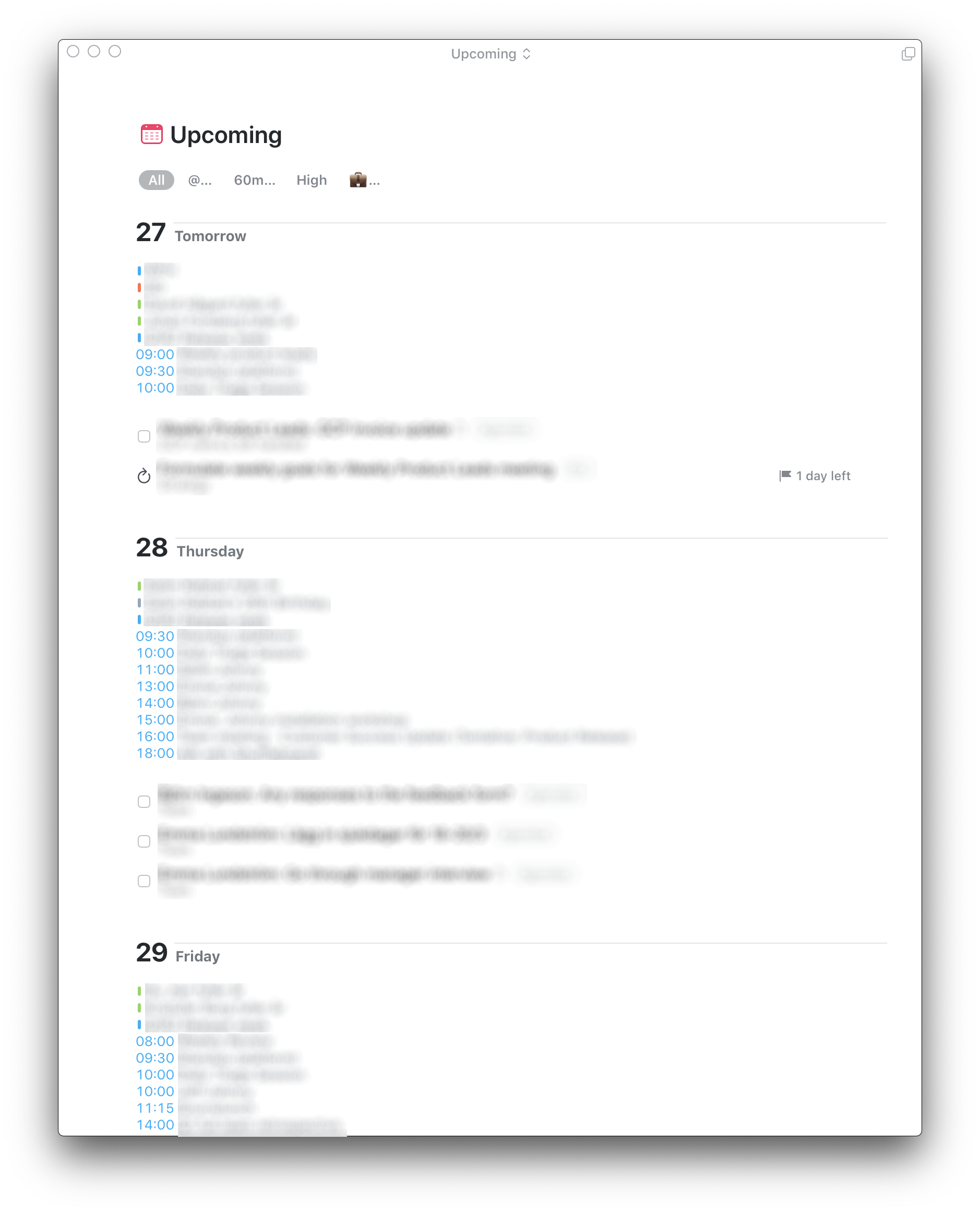
The Someday view is mostly used when doing the Weekly Review, and provides easy access to all the projects marked Someday. The inactive projects are spred out in their respective areas, and this view allows me to quickly see if any projects need to be activated.
Part of the Someday view is also the Guidance area, which contain lists for the higher horizons in GTD3. Another section is Reference, which contain lists that are not necessarily actionable, such as “Next time in…”, which is a place to keep recommendations for different parts of the world and is a great place to look when going to a new destination.
Finally, there are areas that contain Checklists and Templates. The checklists are what they sound like, a list of checklists for recurring procedures and is a great way to learn from past experience when dealing with certain things, such as packing for a trip or performing an interview. The templates are for recurring projects, such as when doing a new release or hiring a new person. The difference compared to Checklists is that Templates are copied for every instance they are used, and there can be multiple copies running at the same time (such as when hiring two people at the same time).
The Logbook is the last builtin view, and contains everything that has been checked off, either as completed but also dropped actions and projects. Reviewing the Logbook as part of the Weekly Review is something that I’m trying out now that I have moved to Things
Daily Workflow
The first thing I usually do when starting up for the day is to perform a daily review. This is not mandated by GTD, but I find it useful to know that my inboxes will be emptied at least once a day. This adds assurance in that I can add anything to my Things inbox and I know I will get to it the morning after at the latest.
When engaging with the lists to actually get some things done, the main view I use is Anytime. The sidebar is usually hidden, which limit distractions and serves as a visual distinction in that I’m in “engage mode” and not something else. In that view, I use the standard GTD criteria to figure out what to do given my current constrains. The first thing I filter on is context, and depending on the amount of actions in that list, I continue filtering on time available and energy. Finally, I may filter on showing only work or personal related actions depending on the situation.
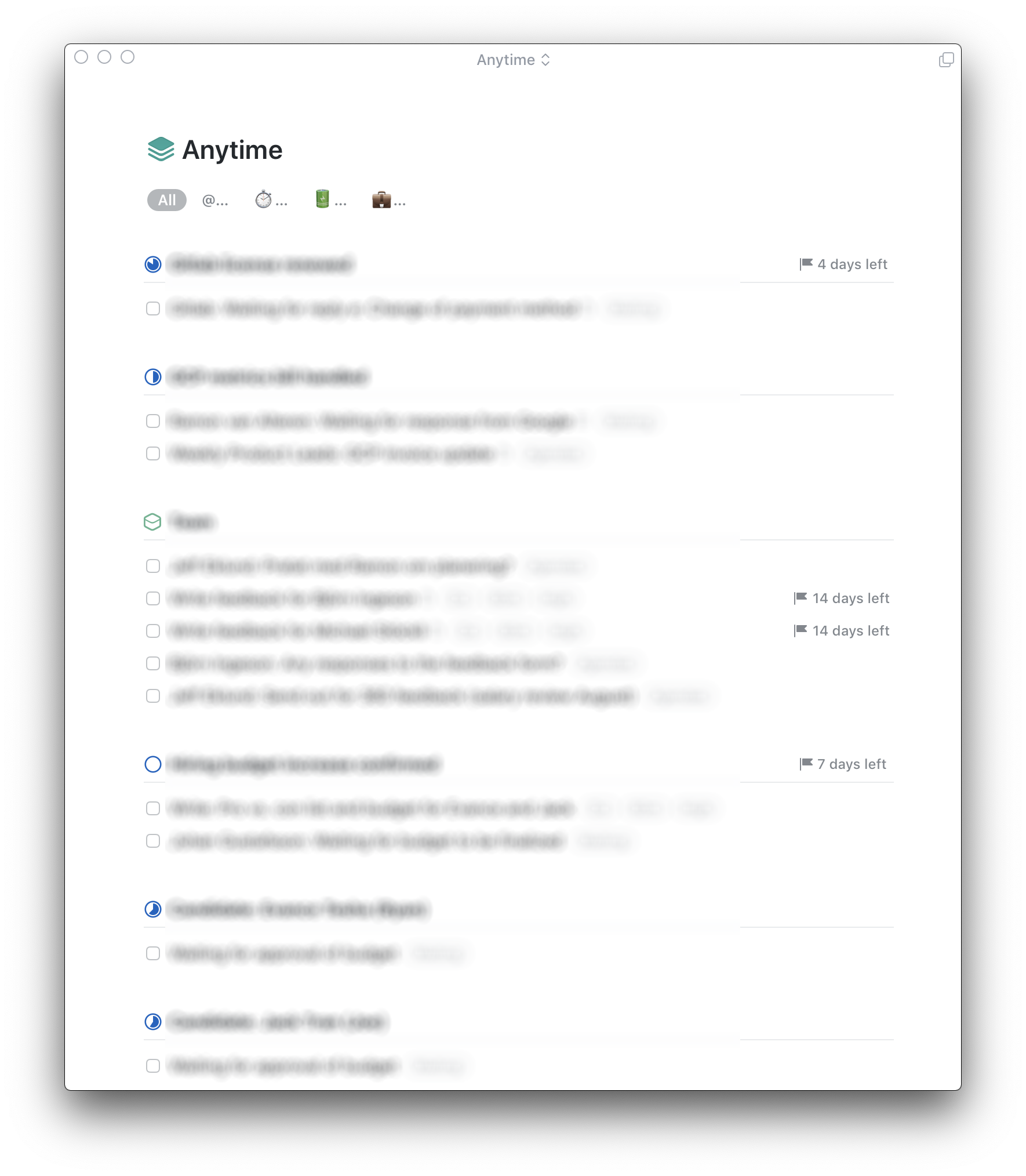
Integrations
I have integrated Things as much as possible with the tools I use on a daily basis. First, email integration is done using the Things Cloud service, where one can send email which then pop up in the Things Inbox, together with a link to the original email. This means that I can click that link and the corresponding email will be opened in Mail. I use this mainly for emails that I want to keep track of replies for. When sending the email, I just BCC my personal Things Cloud email address.
When processing the email inbox however, I mostly rely on drag-and-drop on the Mac and the iPad, or use the clipping shortcut. This workflow allows me to quickly handle the less-than-two-minute emails, and defer the rest to a list in Things with the appropriate tags attached, which are usually “do” and “high focus”, together with “5m” or “15m” depending on the estimated time needed. Once the email is added as an action in Things, I archive the email since I can simply get back to it using the link in the notes section of the action.
Slack is a big thing at work, and I have created an automation in Zapier where if I star a message in Slack, it will end up in my Things inbox for me to process at a later time. This makes handling Slack a lot easier, since I don’t have to rely on marking conversations as unread just to remember to handle them at a later time.


Weekly Review
The weekly review is one of the core parts of GTD, since it keeps everything up to date and relevant. It is essential for making sure that the trusted system remains trusted going forward. I found that the best way to get the weekly review done is to have it scheduled in the calendar, at the same time every week4.
OmniFocus has a built-in review perspective, but I found that not to be all that useful. The idea is great, in that you can have different review periods for different projects, but in practice there are shortcoming with that approach, since if you were to do the review on another day for some reason, the schedule quickly gets out of sync. I also found it easier and more approachable to just review the projects in the normal projects view.
In Things, there is no built in support for doing reviews. What you instead have to do is to just go through each active project and make sure that it's up to date — it's just as simple as that. As I go through area by area and reviewing the projects, I also take a look at all the projects and actions that are scheduled for the near future, so I know what's ahead and if I have missed anything.
Someday projects may not need the same review period as active projects however, but they can be displayed in a separate view, which makes it easy to get an overview and focus on the projects that make sense at the time.
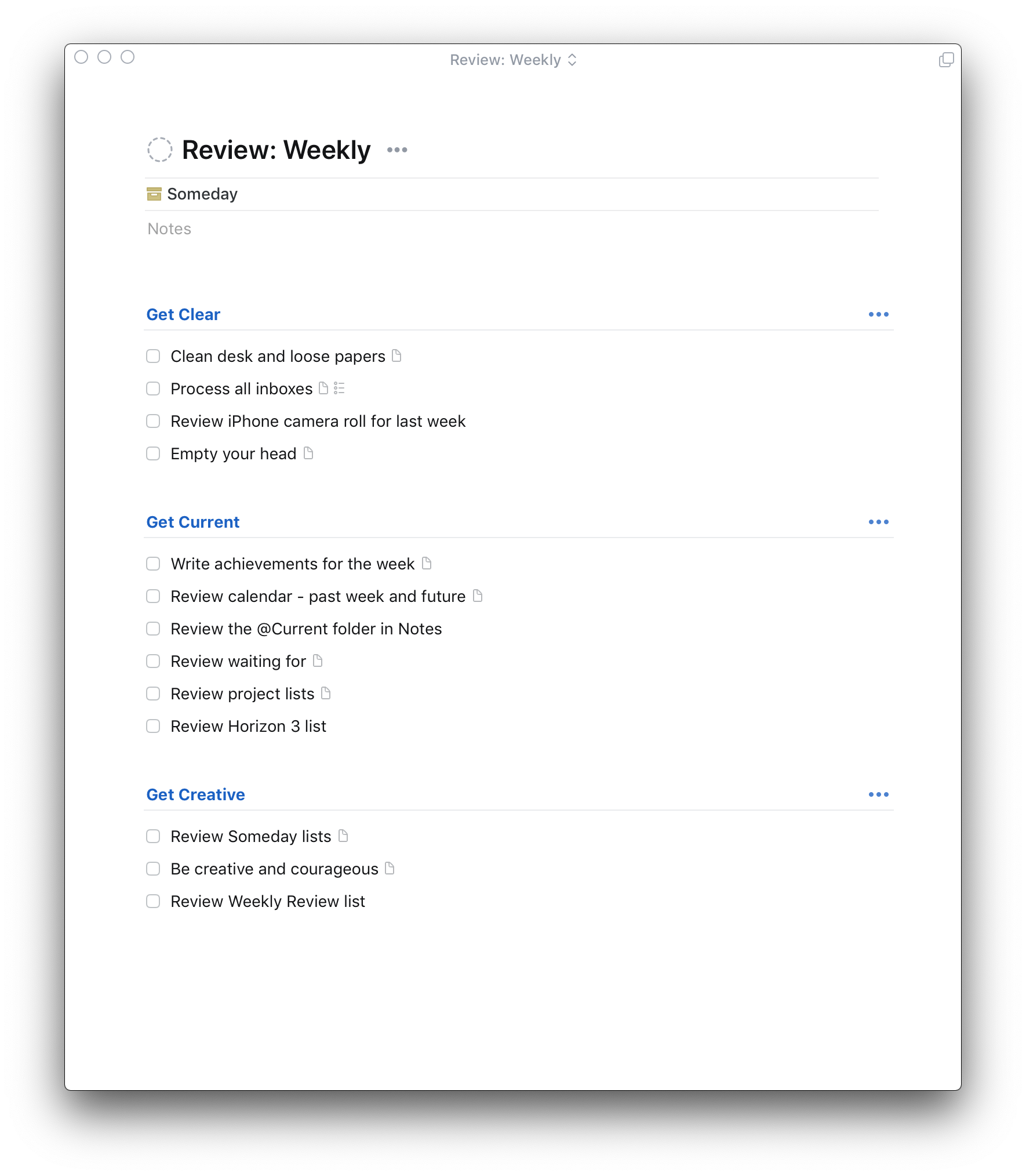
iOS
The first thing I noticed when using Things for iOS, and the iPad Pro in particular, is that the app and how you use it is almost the same as on the the desktop. This is huge, since it has been a major pain point in the past with OmniFocus, where I have refrained from doing certain things on iOS and deferring them to when I'm on the Mac. Things removes the entire discussion of a discrepancy, since the iOS app is fully featured and can do everything that the Mac app can do.
Since I use the third gen iPad Pro 12.9” as my main “computer”, it has been absolutely amazing to be able to use it without limitations, meaning that I can use keyboard shortcuts for everything in Things and now worry about being able to only do certain things on certain platforms. It just removes that discussion altogether.
There are a few things that work a bit different, and the way you choose which tags to focus on is probably the main one. On the Mac, there's a ribbon on top of every view where you can choose which tags to show. On iOS on the other hand, there is a menu option to open the tag selector where tags can be chosen. Once a tag has been activated, adding additional tags is easy, since there's a tag bar presented after choosing the first one, and tapping it will directly open the tag selector window.
When first starting out, I preferred the way choosing multiple tags on the Mac works, but have switched to preferring the way it's done on iOS. What's missing is a quicker way to get to the tag selection window though. Having to first tap the menu button and then choose the tag selector is one tap too many for something this essential.
Another thing differentiating iOS from the Mac version is the difference in how deleted tasks are handled. On the Mac, there's a Trash which shows everything that has been deleted. On iOS however, this doesn't exist, and you are limited to the built in “shake to undo” function to restore any accidentally deleted actions.
Things that bother me
While I am quite impressed by the power of Things, bundled in such a simplistic and appealing package, there are some things that bother me and would definitely make my life easier if they were addressed in some way.
First, one of the core features of OmniFocus is the ability to set projects and sub-projects as sequential, meaning that the second action will become available only after the first one has been completed. I never used sequential projects, since it's way too easy for actions to become invisible if you forget that the project is in fact sequential. What I often used though is sequential sub-projects, which makes it easy to map out a sequence of events and how to handle them. What I would like to see in Things is a way to set actions under a specific project heading as sequential. This provides the best of both worlds, in that the simplicity of Things is intact, while still allowing for power features to be exposed in a simple way. My current workaround is to use a “pending” tag and the remaining actions set as Someday, but that is not really ideal. This is also the thing that could be a dealbreaker sticking with Things for the long haul.
Speaking of project headings, I would also like to see them for areas. This would allow grouping related projects in a simple way. I would like them to also be present in the left menu bar, which would allow me to group my areas into different parts of my life. The workaround for this is to have empty areas with a line for a name to create a divider.
Like I mentioned earlier, choosing tags on iOS is pretty straight forward, however getting to the tag selector the first time is not. I have to first tap the menu button and then the tag selector. For something part of a core workflow, this should be exposed on the main view, like the current behavior when having chosen one tag already.
Another thing related to tags is that when selecting a tag, I would like to only see the remaining tags that provide a result and remove the other ones. This would help a lot when filtering the list to find the appropriate action to work on.
In the Anytime view, you can follow an action to its project, which enables you to quickly access project related information. Going back to the previous view on iOS is easy, just tap the back button and you're back to the Anytime view with all tags applied. On the Mac however, there's no back button, which makes it impossible going back to the previous view once a project link has been clicked.
Summary
I am amazed how well Things 3 works, being such a simple app at first glance. It supports the GTD workflow while still being opinionated in how it wants you to organize everything. I look forward to battle test it for a year and hope it will bring more clarity and help with focusing on the right things.
The only issue I had with the app itself was that an action didn't sync properly from one device to the other. This was fixed by their support, which was quick and friendly.
Now that you have read this entire article, it would help me a lot if you could spend a minute to fill out this feedback form, which will help me better work on similar things in the future.
- The Getting Things Done book recommends first using context to filter the available actions, then time available and energy. Finally using a subjective priority when looking at the remaining actions. The reason priority isn't a tag is simply because it can change too often depending on outside factors. ?
- The context normally called @computer, is called @do in my system, because I can do most things on that list both from an iPad, as well as using my Mac, and some of them even using my iPhone. ?
- The higher horizons are split up into three different areas. Horizon 3 is about short-term (1-2 year goals), Horizon 4 is about a long-term vision on your outlook. Finally, Horizon 5 is about your purpose. ?
- There are of course exceptions to this, since other meetings may have to take precedent. It is the exception, and if that happens, I make sure to schedule it for another time during the day. ?